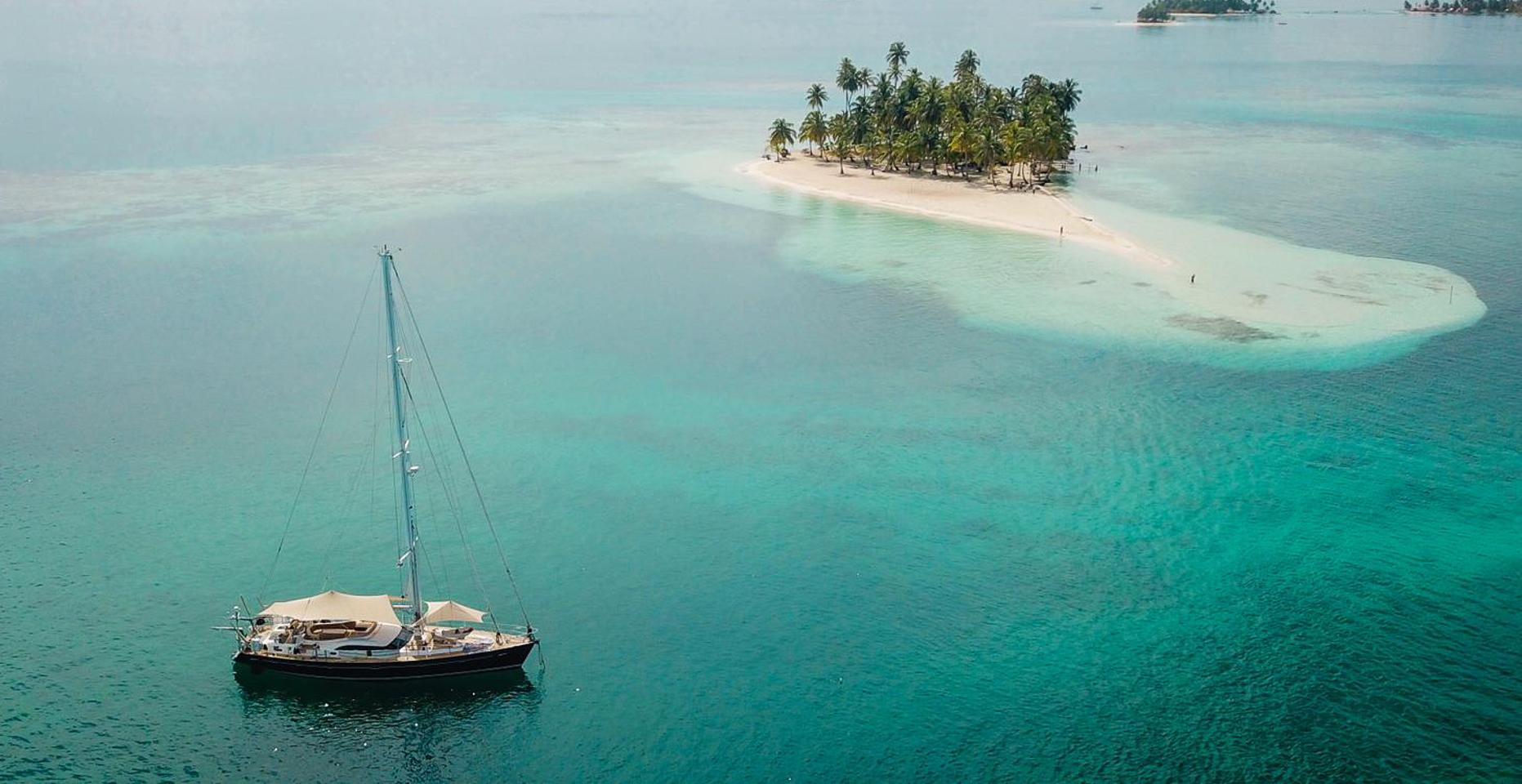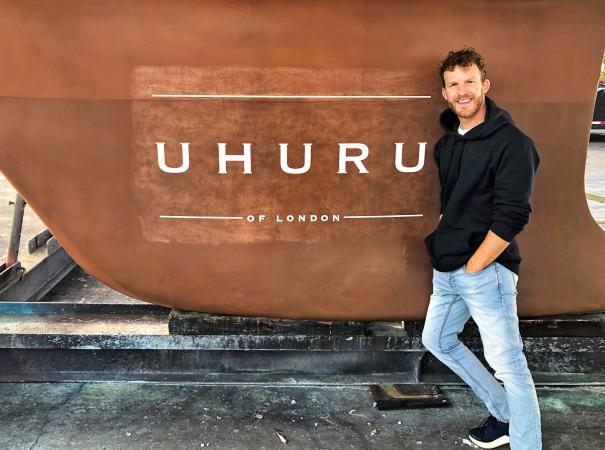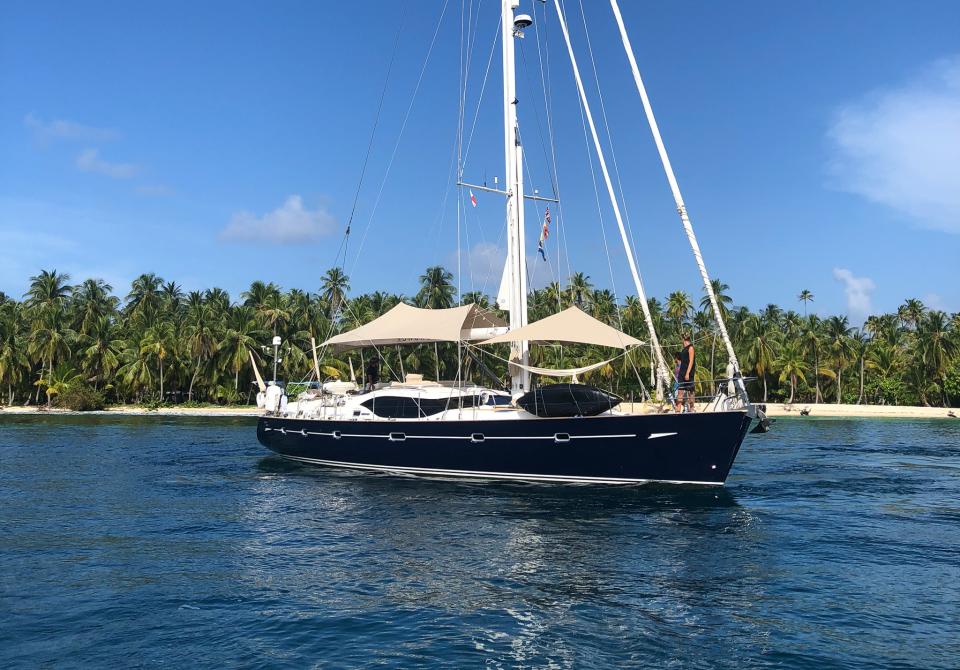Three years after setting out from the UK and with 17,000 miles under Uhuru’s keel, including visits to 34 nations, James and his crew are in New Zealand sitting out the Covid crisis. But in keeping with a positive approach that has characterised their trip from the start, they have used the time to their advantage and have been undertaking a re-fit of Uhuru.
Their trip so far has been a fascinating one that has seen Uhuru’s crew take a very different approach to a Pacific crossing, so while James was on terra firma, I took the opportunity to ask him about some of the most memorable parts of the Pacific crossing, along with some of his favourite places.
DISCOVER HOW OWNER AND CREW OF OYSTER 62 UHURU TOOK THE PASSAGE LESS TRAVELLED TO EXPLORE SOME OF THE MOST BEAUTIFUL, UNTOUCHED CORNERS OF THE GLOBE.
He began by outlining how they had set about planning the trip.
“After our time in the Caribbean, we sat down and asked ourselves what we had learned that we could carry forward for our trip,” he explained. “And there were three things.
“The first was to maintain our four to one ratio of time under sail to time on land. And that meant that whatever we did, we had to drastically cut down the number of planned visits, or dramatically increase the time that the trip would take.
“The second was to be a lot more relaxed about visitors and not committing to a specific time and a place a long way out which risked putting us under pressure. Instead, we would tell them the area that we would be by a certain date and that they may have to then be prepared to wait for a few days to get joining instructions. It worked well for both sides.
“And the third thing we realised was that our best adventures had been the ones that were off the beaten track. For example, in the Caribbean it had been anchoring off the coast of the Dominican Republic that is a breeding ground for humpback whales. It’s 12 metres deep in the middle of nowhere and we spent a couple of days there, surrounded by baby humpback whales, and diving in the water with them. It was superb.
“So, our plan for the Pacific was to get away from the main cruising routes as much as possible and it proved to be spot on.”
So, our plan for the Pacific was to get away from the main cruising routes as much as possible and it proved to be spot on.
As they left Panama and with the majority of the cruising fleet heading for Galapagos or the Marquesas islands, Uhuru turned north to Costa Rica.
“We wanted to go to Isla del Coco,” he continued. “The problem is that to go there you have to leave from Costa Rica, which means heading something like 500 miles north first. We also had to go there to pick up the scuba diving instructor that we had pre-booked. It is a legal requirement to have one if you’re going to dive in Isla del Coco.
“It was well worth the effort though. There was no one else there, just us and our boat on this uninhabited island. We were diving around three times a day and each time we’d be with amazing sea life including huge hammerhead sharks, bait balls of fish, Galapagos sharks.
“There is a liveaboard dive boat that arrives every two months, so we timed it so that our guide could get off onto this boat which would take him back to Costa Rica.
”It was clearly a trip that was worth doing, but drill down into the detail and the project took a good bit of planning.
“It took around six months to organise,” he said. “Of course, now I know what to do I could do it a lot quicker next time around, but there are all kinds of things that you need to consider and sort out, not least of all whether your guide is prepared to sail on your boat for three or four days and sleep on one of the settee berths, on what was quite a busy boat. Plus of course, arranging enough scuba gear for eight people and so on. But it was completely worth the effort.”
Crew changes meant that Galápagos was the next stop for Uhuru.
“We spent a month there in total which was great. But during our stay we met a couple, Simon and Pippa, who inspired us to head to Easter Island. This was in contrast to most boats that were heading to the Marquesas.
“It took us a while to decide to do it, mainly because we were apprehensive about it and had quite a few people telling us that Easter Island wasn’t such a great idea and was difficult, even dangerous. But we looked at it really carefully and in the end decided to go.
“I have to admit that while the trip was fine, I did have a bit of a panic attack at one point. I think I just got spooked for a moment, it’s easily done when you look at the chart and see just how far away from civilisation you are. Midway between South America and New Zealand you really are in the middle of nowhere, heading into the abyss, towards the Southern Ocean.
“It was upwind for most of the way and we were bashing into swells coming up from the south so it wasn’t particularly pleasant sailing.
“We did have two days with no wind and on Easter Sunday we stopped for a swim around the boat in middle of nowhere followed by a big roast lunch which was pretty cool. But, after 17 days sailing, when we got there we discovered that Easter Island is not what people had led us to believe.
“The popular impression is of desolate views and huge statues, but the reality is that that is only a part of it. Instead, there are beautiful beaches, palm trees, wildflowers, hibiscus flowers and little cafes and bars, it’s absolutely beautiful. In fact, I plan to go back for a month or two.
”The visit wasn’t without its challenges though. “Anchorages are a problem. When we got there, the main port was closed because of a large swell, so we had to hide around the corner in another anchorage which wasn’t very comfortable.
“The port was closed for some time so the only way we could get ashore was to put our wetsuits on, put our gear into waterproof bags and get on our surfboards and head for the shore.
“We had an amazing two weeks there and wish we could have stayed longer.”
There are beautiful beaches, palm trees, wildflowers, hibiscus flowers and little cafes and bars, it’s absolutely beautiful.
By this stage, James and his crew were getting used to the new level of remoteness, at least they thought they were. And then came Pitcairn.
“There is something incredibly strange about arriving in a UK territory in the middle of nowhere, and I mean nowhere! Easter Island is remote, but Pitcairn is one step more.
“When you get there you just see this solitary rock and as we approached and listened on the radio you hear UK Somerset accents. Right from the off, before we had even arrived they were so welcoming, inviting us to a party that evening before we’d even got ashore.
“Not that many people get to go there and it’s easy to see why as the anchorages are pretty horrendous. But we were really lucky with our approach and were the only boat in the anchorage.
“A quad bike collected us and took us up to the top of the island where it seemed that the entire population was indeed out for a party. It’s a fantastic and charming island and we stayed there for quite a while. The locals were really friendly and took us spear fishing and showed us the ballast of the Bounty, which is, of course, one of the things that this area is famous for.”
But if Pitcairn felt special, the volcanic island of Ducie to the east felt even more remote.
“I think I read somewhere that only 100 boats have visited this island and I wouldn’t be surprised. There is no anchorage at all. It’s a lagoon with thousands of birds as it is a breeding ground for petrels and shearwaters.
“The weather was very kind to us and we managed to find a tiny patch of sand to anchor in which meant we were able to get ashore for a beach barbeque. It was a beautiful but surreal moment when we thought about how we were 3,000 miles from anywhere, other than Pitcairn, sitting on a beach.
But there was a really sad part to this and that was the amount of plastic that had been washed up on the island, it’s all over the place, it’s heart breaking.
Acutely aware of just how quickly conditions could change and how untenable their anchorage would become, two nights was all the team dared to stay.
From here, as they continued towards New Zealand, their trip took them via French Polynesia, Society Islands and then the Cook Islands.
“One of the things I was very diligent about was emailing ahead to where we were going to ask whether there was anything we could bring to help, which was very much appreciated. In return, we were often given loads of fruit and vegetables which was great.
“In the Cook Islands we did the same thing, but this time we were asked if we could take a girl who was a relative of someone on another island which was about a six or seven day sail away. We said that would be fine, but then later on she asked if she could bring a boy that she had met which we agreed to. But then, when the day came and she turned up on the dock, she had a mountain of kit from bags of rice, potatoes, crates of Coca Cola, a TV and plenty more, there must have been a tonne in weight, it was crazy.
“In the end we managed to squeeze it all into a bag that we strapped down on the foredeck. When we got to the island, the local family were so grateful and invited us to stay with them, they cooked for us and took us to some amazing remote atoll where we camped overnight on the beach. It was a really special visit.
“Another amazing place we stopped at was Niue. It’s another tiny island with no places to anchor as it rises 300m straight up from the sea bed, but we managed to get one of the remaining deep water moorings. We were very lucky because there were boats coming all the time that had been sailing for a week and had to pass by and keep going as there was nowhere to stop.
“From there, Tonga was our next stop which was memorable for being one of the few places where you can swim with humpback whales. Then it was Fiji, before heading south for New Zealand.”
Having spent a year in New Zealand working on the boat, James has also been planning the next stage of their adventure which was due to take Uhuru and her crew further west. But now James has other plans.
“I’m not convinced that the Covid situation will have been resolved sufficiently that things will open up in 2021. By June time it will be too late to start the next stage of our trip, which was to head to New Guinea and I don’t want to spend the whole year nervous and worried about what lies ahead, so I’ve decided to head back to French Polynesia.
“We’re going to go back and do it all over again. And I couldn’t be more excited.”
If you need more inspiration you can follow Uhuru’s adventure on Instagram @uhuruoflondon.












